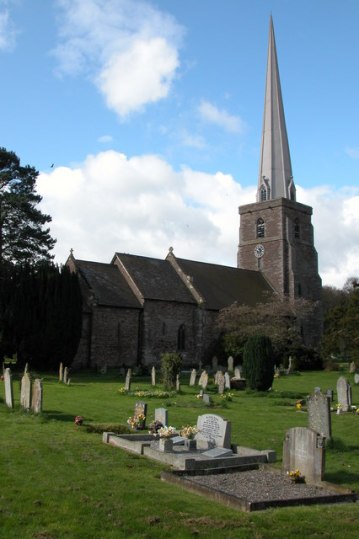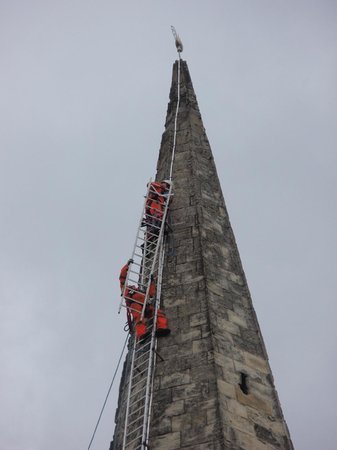You can see it from a long way off as you drive over the ridge from the East into the valley, up the valley from the southern end, or down it from the northern end. Pointing skyward, it rises from among the trees that surround it and the village. Few visitors in the twenty first century realise that it is made of plastic – glass fibre reinforced resin to be precise.

In the late nineteen fifties and early sixties Easter was the time of the Aldermaston Marches. Organised by a group of pacifists under the leadership of the philosopher Bertrand Russell and known as The Campaign for Nuclear Disarmament (CND), the idea was to spend the four days of the Easter weekend walking from the British Atomic Weapons Research Establishment at Aldermaston, in Berkshire, to London’s Trafalgar Square, a distance of around 50 miles. At the end of the march a mass rally took place proclaiming the participants’ rejection of nuclear warfare.
In 1961 this movement attracted the ire of one particular Church leader in my home county of Herefordshire. His letter, denouncing the participants as traitors, was published in our weekly newspaper, the Hereford Times. My reaction – I was aged nineteen at the time – was to wonder what had become of the Christian concepts of “turning the other cheek” and “loving your enemies”. Whilst Russell was a well known atheist, there were politicians and Church leaders among the organisers, and those making impassioned speeches at the rally.
traitors, was published in our weekly newspaper, the Hereford Times. My reaction – I was aged nineteen at the time – was to wonder what had become of the Christian concepts of “turning the other cheek” and “loving your enemies”. Whilst Russell was a well known atheist, there were politicians and Church leaders among the organisers, and those making impassioned speeches at the rally.
I wrote expressing my view that the writer of the original letter, though purporting to be someone charged with promulgating the Christian faith, was putting forward a demonstrably unChristian view of those opposed to nuclear weapons. The following week it appeared on the Hereford Times’s letters page. It was the first time I’d seen my name in print, associated with something I’d written. It brought a flush to my cheeks and set my heart racing.
It also brought an invitation to join an organisation called the Anglican Pacifist Fellowship. Years later I resigned from the organisation, explaining that, whilst I still held strongly to the belief contained in their mission statement that “war is incompatible with Christianity”, I had concluded that there are circumstances, such as those that pertained in Europe in 1939, in which war becomes necessary. To remain consistent, I must reject Christianity. Of course, there were and remain other reasons to reject, not just Christianity but all formal religious organisations.
I return now to the plastic spire on the church in the village in which I grew up, and, with it, another letter of mine that was published some years later in the Hereford Times.
I was seven years old and attending primary school in the summer of 1949 when it became the habit of my classmates and I to spend playtime standing at the bottom of the school playground staring skywards as a small band of steeple jacks dismantled the ancient stone steeple.

The excitement in our childish minds, seeing those men working at such a great height, is difficult to comprehend today. You have to remember that we did not have television, let alone the internet, on which to witness extraordinary events. Some of our number might have visited the cinema in Hereford to see cowboys and Indians or cops and robbers on the screen – conflicts that inspired our playtime games once the job was completed and the real life spidermen had departed to the next job wherever that was. By the way, the fictional character, Spider-Man would not make his debut in a comic book for another 13 years.
The dismantlers left behind a stump. Its top surface was covered with lead sheet to protect the interior. The weather vane, in the shape of a cockerel, that had perched atop the spire, was removed to storage. Every year for the next two decades it re-emerged to be displayed in a tent at the annual village Sports and Flower Show where people were charged to view it. All of the proceeds from that annual show, and many other fund raising activities over the period, were allocated to a special fund to meet the cost of a replacement spire. Every time a target was reached, inflation had pushed the estimated cost of erecting a stone spire way beyond it and a new target had to be set. It seemed that the stump that I and my contemporaries grew up with was there to stay.
My letter to the Hereford Times some time in the mid 1960s expressed my view that there were many more important things that a supposedly Christian community could do with the money, rather than the erection of a totem to human achievement. The official view, according to the Church’s website, is that the spire stands “as originally intended [when first constructed 700 years ago], to lift our eyes upward to remind us of the greatness of God.”
It was in 1972, with inflation pushing the target for fund raising ever higher, that the decision was taken to commission a plastic spire. This time there was no need for steeple jacks. The spire was fabricated off site and lifted into position by crane. The crane’s 240 foot jib made it the largest mobile crane in Europe at the time. No doubt the 1972 generation of school children watched with the same fascination that had gripped us 23 years before. Though this time the operation probably took only one day whereas the dismantling we witnessed continued over several days.
The weather cock, too, was lifted into place though it later blew off in a gale. As for me, I still am unable to resist the urge to express my opinions in writing and to publish them wherever I can. When I look skywards, it is not to be reminded of “the greatness of God” but of the futility of human attempts to appeal to a deity for the relief of their suffering when direct action is more likely to produce the desired outcome. And, in fairness, I ought to add that the village church now has a community centre operating from within its walls, suggesting that it does now minister to the material as well as the spiritual needs of the village’s inhabitants.

Reblogged this on Rebecca Bryn and commented:
I love this post.
LikeLiked by 1 person
Thank you!
LikeLike
Great post, Frank.
LikeLiked by 1 person
There’s no doubt the church establishment has plenty to answer for and has often departed entirely from its purpose, so much so that I wonder whether Jesus would recognise most of its adherents as his followers when he returns? One of Satan’s greatest deceits possibly has been to create ‘religion’ within the minds of men as expressed in the multiple ways it is today to blind us to the simplicity of relationship with God. Thanks for your honest and insightful post.
LikeLiked by 1 person
To see how far mankind has come in using ‘God’ as the excuse for what I view as un-Christian acts, bordering on the inhumane, you only have to look at the US. I too have difficulty in accepting the concept of an omniscient deity, which makes for the occasional interesting chat with my stepmother, who is an Anglican priest. Far better, in my view, to attempt to do good for others because it is the right thing to do, rather than doing bad things because they are ‘God’s will.’ A benevolent, charitable God wouldn’t agree with them. Bring on the plague and locusts!
LikeLiked by 1 person